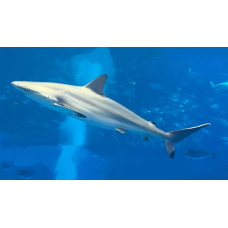Latin name
Carcharhinus sorrah
Other name
Sorrah shark
Identification
The spotted shark has a spindle-shaped body with a long, rounded snout, large round eyes and serrated teeth.
Features of fish fins
Dorsal spines (total): 0; Anal spines: 0.
The second dorsal fin is very low. There is a ridge between the first and second dorsal fins.
Fish colouring
Spot-tail sharks are grey or grey-brown in colour, with a white belly and golden brown between the eyes and gill slits. They have dark tips on the second dorsal, pectoral and lower lobe of the caudal fin. The tips of the first dorsal fin, the pelvic fins and the upper blade of the caudal fin also have subtle but noticeable dark markings.
Distribution
Widespread in the Indo-West Pacific: in the Red Sea and off East Africa (including Madagascar, Mauritius and the Seychelles), the Philippines, from the north coast of China to Australia and the Santa Cruz Islands. May also occur in the Gulf of Aden, Gulf of Oman and off Sri Lanka.
Habitat
Occurs between 31°N and 31°S on continental and island shelves close to shore at depths of up to 140 m. Prefers sandy bottoms but can also be found near coral reefs. Juveniles prefer shallow coastal waters.
Size
The spottail shark grows to a length of 160 cm with a maximum recorded weight of 28 kg. The maximum documented lifespan is 8 years.
Behavior
These sharks stay near the bottom during the day and rise to the surface at night. They usually travel short distances, not exceeding 50km, but there are reports of migrations of over 1000km.
Food and feeding habits
The spotted shark's diet consists of bony fish (such as tuna and sea bass), cephalopods and crustaceans.
Reproduction
Like other members of the genus Carcharhinus, they are viviparous; developing embryos are nourished by a placental connection to the mother formed by an empty yolk sac.
In Australia, Carcharhinus sorrah sharks reach sexual maturity when they reach a length of 90 cm (males) and 95 cm (females) at the age of 2-3 years. Pregnancy lasts 10 months. Females give birth once a year. A litter contains from 1 to 8 cubs (average 3). The size of the newborns is about 50 cm. The growth rate of juveniles is 20 cm during the first year, and decreases to 5 cm per year when the sharks are 5 years old.
Fishing
Regularly caught as by-catch in gillnets and longlines. Under heavy fishing pressure, particularly in the Red Sea and Gulf of Aden, and also suffering from habitat degradation. The harvest of these sharks off northern Australia is regulated. The IUCN has assessed the conservation status of this species as Near Threatened (NT).
Relationship with a person
This species is not dangerous to humans. It is used as a food fish; fins are used in the eastern shark fin trade, liver is used for vitamin oil and offal is used for fishmeal.
| Classification | |
| Phylum | Chordata |
| Class | Chondrichthyes |
| Squad | Carcharhiniformes |
| Family | Carcharhinidae |
| Genus | Carcharhinus |
| Species | C. sorrah |
| Features | |
| Conservation status | Near Threatened |
| Habitat | Pelagic |
| Life span, years | 8 |
| Maximum body weight, kg | 28 |
| Maximum length, cm | 160 |
| Sailing speed, m/s | No information |
| Threat to people | Edible |
| Way of eating | Predator |
Spot-tail shark
Tags: spottail shark


